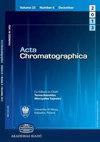A green HPLC method for determination of mirtazapine in pharmaceutical products: Development, validation, and greenness assessment
IF 1.7
4区 化学
Q3 CHEMISTRY, ANALYTICAL
引用次数: 0
Abstract
Abstract Mirtazapine is an antidepressant medication used to treat the major depressive disorder in adults. In this study, two different chromatographic methods were developed for the determination of mirtazapine in pharmaceutical products. In the first method, An Extend C 18 column (250 × 4.6 mm, 5 μm) was used and the temperature was kept constant at 25 °C. The mobile phase was determined as 0.1% formic acid solution and acetonitrile (80/20, v/v), and isocratic elution was applied. The flow rate of the mobile phase was determined as 1.0 mL min −1 and the injection volume was 20 µL. Detection was performed at 291 nm. using a UV detector. In the second method, ethanol was used as the organic modifier. The only difference between these methods was the organic modifier. All other conditions of the methods were the same. Both chromatographic methods were validated by ICH guidelines for various parameters such as selectivity, linearity, accuracy, precision, detection and quantification limit, and robustness. The determination coefficients of chromatographic methods were greater than 0.999 in the concentration range of 5–30 µg mL −1 . of mirtazapine. Later, these chromatographic methods were applied to pharmaceutical formulations. Comparison of the obtained results in terms of means was made using Student's ( t ) test, and comparisons in terms of standard deviations were made using the Fischer (F) test. It was observed that there was no significant difference between these methods. These two methods were then evaluated using the AGREE-Analytical GREEnness metric software. The chromatographic method using ethanol as an organic modifier has been proposed as an excellent eco-friendly and analyst-friendly alternative for the determination of mirtazapine in pharmaceutical formulations.绿色高效液相色谱法测定药品中米氮平:开发、验证和绿色评价
米氮平是一种用于治疗成人重度抑郁症的抗抑郁药物。建立了两种不同的色谱法测定药品中米氮平的含量。第一种方法采用An Extend C 18色谱柱(250 × 4.6 mm, 5 μm),温度恒定在25℃。流动相为0.1%甲酸溶液-乙腈(80/20,v/v),等密度洗脱。流动相流速为1.0 mL min - 1,进样量为20µL。在291 nm处检测。使用紫外线探测器。第二种方法以乙醇为有机改性剂。这些方法之间的唯一区别是有机改性剂。所有方法的其他条件相同。两种色谱方法均通过ICH指南验证了各种参数,如选择性、线性、准确度、精密度、检测和定量限以及鲁棒性。在5 ~ 30µg mL−1的浓度范围内,色谱法的测定系数均大于0.999。米氮平。后来,这些色谱方法被应用于药物制剂。采用Student’s (t)检验比较所得结果的均值,采用Fischer (F)检验比较标准差。结果表明,两种方法间无显著性差异。然后使用AGREE-Analytical GREEnness度量软件对这两种方法进行评估。以乙醇为有机改性剂的色谱法是测定药物制剂中米氮平的一种环境友好的方法。
本文章由计算机程序翻译,如有差异,请以英文原文为准。
求助全文
约1分钟内获得全文
求助全文
来源期刊

Acta Chromatographica
化学-分析化学
CiteScore
4.00
自引率
0.00%
发文量
55
审稿时长
2.3 months
期刊介绍:
Acta Chromatographica
Open Access
Acta Chromatographica publishes peer-reviewed scientific articles on every field of chromatography, including theory of chromatography; progress in synthesis and characterization of new stationary phases; chromatography of organic, inorganic and complex compounds; enantioseparation and chromatography of chiral compounds; applications of chromatography in biology, pharmacy, medicine, and food analysis; environmental applications of chromatography; analytical and physico-chemical aspects of sample preparation for chromatography; hyphenated and combined techniques; chemometrics and its applications in separation science.
 求助内容:
求助内容: 应助结果提醒方式:
应助结果提醒方式:


